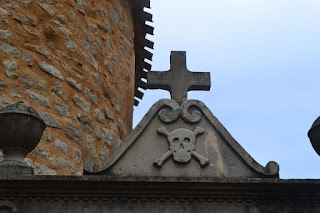Il quadro di Nicolas Poussin "I pastori di Arcadia" rappresenta un dipinto del ca. 1640 con dei pastori che guardano rapiti una tomba, cercando di decifrare la scritta su di essa "Et in Arcadia ego". La frase in latino si traduce letteralmente: anche in Arcadia io. Benché sia una frase frequentissima presente in alcuni dei dipinti più importanti del seicento, gli pseudo storici analizzano alcuni aspetti della grammatica latina e concludono che la frase è incompleta del verbo, e speculano sul fatto che questa frase possa celare un qualche messaggio esoterico, occultando un codice (probabilmente anagrammatico). Sotto la falsa impressione che "et in Arcadia ego" non sia una frase latina vera e propria, hanno proposto che si trattasse dell' anagramma di I! Tego arcana Dei, che si tradurrebbe in "Vattene! Io celo i misteri di Dio", suggerendo che la tomba nel dipinto contenga i resti di Gesù o di un'altra importante figura biblica. Si sostiene che Poussin fosse a conoscenza di questo segreto e che il dipinto rappresenti una località realmente esistente. Facendo alcune ricerche su internet, ho letto spesso e volentieri che il paesaggio nel dipinto ricorda quello attorno al mistico villaggio di Rennes-le-Château e quando finalmente sono riuscita a visitare questo posto sperduto fra le montagne, anche io, devo dire che ho pensato spesso al dipinto di Poussin. Chissà se il pittore dipinse di proposito il quadro, volendo nascondere un messaggio o addirittura sapendo quello c'era nella tomba che stava dipingendo...Non lo sapremo mai, ma intanto lo splendido dipinto rimane uno dei più affascinanti che abbia mai visto. Se vi capita di visitare il Louvre, I pastori di Arcadia saranno lì ad attendervi!
The painting by Nicolas Poussin "The Arcadian Shepherds" is a 1640 painting representing shepherds watching kidnapped a grave, trying to decipher the writing on it: "Et in Arcadia ego". The Latin phrase literally means: even in Arcadia there I. Although this phrase is very frequent in some of the most important paintings of the seventeenth century, the pseudo historians analyze some aspects of Latin grammar and conclude that the sentence hasn't a verb, and speculate that the sentence can conceal some esoteric message, concealing a code (probably anagrammatic).
Under the false impression that "Et in Arcadia ego" is not a Latin phrase itself, they suggested that it was the anagram of I! Tego arcana Dei, which means "Go away! I conceal the mysteries of God, suggesting that the tomb in the painting contains the remains of Jesus or other important biblical figure. It is claimed that Poussin had knowledge of this secret and that the painting represents a place that actually exists. Doing some research on the internet, I read often that the landscape in the painting reminiscent around the mystical village of Rennes-le-Château and when I finally managed to visit this remote place in the mountains, I must say that I thought often about Poussin's painting. I wonder if he wanted to hide a message or even knew what was in that tomb... We'll never know, but in the meantime the remarkable painting remains one of the most beautiful I've ever seen. If you have the chance to visit the Louvre, The Arcadian Shepherds painting will be there waiting for you!
The painting by Nicolas Poussin "The Arcadian Shepherds" is a 1640 painting representing shepherds watching kidnapped a grave, trying to decipher the writing on it: "Et in Arcadia ego". The Latin phrase literally means: even in Arcadia there I. Although this phrase is very frequent in some of the most important paintings of the seventeenth century, the pseudo historians analyze some aspects of Latin grammar and conclude that the sentence hasn't a verb, and speculate that the sentence can conceal some esoteric message, concealing a code (probably anagrammatic).
Under the false impression that "Et in Arcadia ego" is not a Latin phrase itself, they suggested that it was the anagram of I! Tego arcana Dei, which means "Go away! I conceal the mysteries of God, suggesting that the tomb in the painting contains the remains of Jesus or other important biblical figure. It is claimed that Poussin had knowledge of this secret and that the painting represents a place that actually exists. Doing some research on the internet, I read often that the landscape in the painting reminiscent around the mystical village of Rennes-le-Château and when I finally managed to visit this remote place in the mountains, I must say that I thought often about Poussin's painting. I wonder if he wanted to hide a message or even knew what was in that tomb... We'll never know, but in the meantime the remarkable painting remains one of the most beautiful I've ever seen. If you have the chance to visit the Louvre, The Arcadian Shepherds painting will be there waiting for you!


















